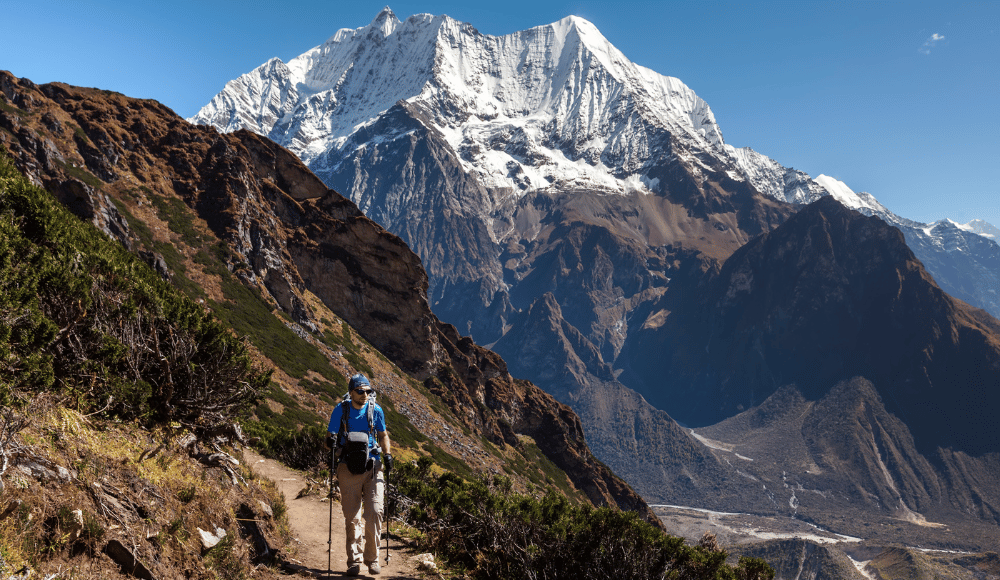The Manaslu Circuit Trek is a reasonably challenging hike. It’s one of Nepal’s hardest hikes, requiring a strong will and extreme physical fitness. The Manaslu region attracts a respectable number of trekkers each season, despite its difficulties. The Manaslu Circuit Trek’s difficulty is determined by several aspects, which we will address later. But even novice hikers may reach Manaslu with significant preparation and careful planning.
Many people are afraid of the challenging terrain of the 12-day Manaslu Trek, but ardent hikers who have already finished other well-known treks in Nepal love it. It is also a paradise for those who enjoy isolation and want to discover unspoiled nature free from human intrusion. There’s no better place to lose yourself in the natural world than the Manaslu region, which boasts some of the most breathtaking Himalayan vistas. Think snow-capped mountains, verdant hills, dense forests, azure skies, immaculate waterfalls, and thunderous rivers. The walk is made even more picturesque by the little settlements, each of which has a distinct culture and way of life.
One of Nepal’s newest hiking routes, the Manaslu Trek, only welcomed tourists in 1992 and calls for a unique “Restricted Area Permit.” All of it centers on Mt. Manaslu, the eighth-highest
summit of the globe, rising to a height of 8163 meters above sea level.
What makes the Manaslu Trek difficult?
No trek is challenging by itself. The Manaslu Circuit Trek’s difficulty is influenced by a number of factors. Let’s examine each one in more detail.
Remote Location
Despite being approximately 140 km away from Kathmandu at the trek’s beginning point, Soti Khola, the Manaslu region is far from the capital because of the rugged Himalayan terrain. There is no airport that links Manaslu and Kathmandu, unlike the Everest region. To reach the trailhead, hikers must endure a lengthy bus ride over hazardous off-road terrain. For someone who has never driven on such uneven and winding roads, it might be a nightmare. You’re in good hands since, thankfully, the drivers on these roads are extremely knowledgeable and experienced. After all, this is a trip of a lifetime!
Tough Terrain
This is the point when you will need to utilize your body. You will be hiking right in the enormous Himalayas’ foothills. Because of the trail’s sheer cliffs, massive boulders, and steep slopes, the Manaslu journey is psychologically and physically taxing. The trail has a number of ups and downs from the beginning, making it difficult. The journey’s uncharted, off-the-beaten-path sections significantly raise the difficulty level. The trail will test your mettle with a plethora of natural barriers, river crossings, and other challenging terrains. In order to partake in this kind of high-altitude trekking as experienced on Manaslu, one needs to possess incredible endurance and fitness. For this reason, getting ready properly is crucial for the hiking trip.
Trek Distance
From Soti Khola, the starting point of the Manaslu Circuit, to Dharapani, the endpoint, is approximately 177 kilometers away by foot. It is longer than the 130-kilometer Everest Base Camp trek. You will be trekking in the untamed landscape of Manaslu for ten to twelve days straight, with an itinerary that often lasts fourteen to sixteen days. You’ll be hiking 10 to 15 km every day at that rate, which is rather strenuous for a first-time hiker. Even experienced hikers may find it difficult given the difficult terrain. Thus, physical fitness saves the day once more. When you go trekking, make sure your health is at its peak.
Weather & Climate
One of the main elements that increases the challenge of the Manaslu trek is the weather. Six climate zones are covered by the Manaslu Conservation Area, which has continuous snow lines over 5,000 meters. The seasons and climate zone have an impact on this place’s temperature.
In the winter, dealing with inclement weather, windstorms, and icy conditions can be difficult. The days are usually comfortable, but the night and morning can get very cold if there’s a sharp drop in temperature. Because of this, winter trekking is almost difficult. Wintertime brings with it the bitter weather and the closure of numerous tea establishments. In addition, there is a lot of snow, making Larkya La Pass unreachable.
The hiking trail passes across steep terrain that can experience landslides and landfalls during the wet season. For this reason, trekking during the winter or during the monsoon is never a good idea. The ideal seasons for the excursion are said to be spring and fall. All year long, nevertheless, the weather in the Manaslu region is erratic.
Altitude Sickness
There is a significant danger of altitude sickness, also known as acute mountain sickness (AMS), when doing the Manaslu Circuit walk. The walk ranges in altitude from 600 meters to 5106 meters at Manaslu Larke La Pass. When traveling over 3000 meters, anyone can get altitude sickness, regardless of age or degree of fitness. Early signs of AMS include headache, lightheadedness, nausea, vomiting, fast heartbeat, trouble falling asleep, etc. Hydration, adequate rest, and acclimatization can help handle minor symptoms. But if things become problematic, the patient should be flown to a lower altitude, or if the situation is too bad, they might even be evacuated to Kathmandu.
Accommodation
Accommodation is a big issue for hikers doing the Manaslu trip. Owing to its isolation, the trail lacks numerous lodges to house the hordes of tourists that arrive in Manaslu during peak season, bringing commotion and good weather with them. Even if you were able to get the room, it won’t be luxurious. The most common lodging options in the area are locally owned lodges and tea rooms. Depending on the price range, the majority of tea houses offer rooms with single or double beds and either an en suite bathroom or none. During the busiest trekking season, it is not only difficult but impossible to find accomodation at the last minute, thus it is best to book the rooms in advance.
Food & Drinks
All of the food on the trail is either produced nearby or is transported from the lower towns over several days. It is therefore impossible to receive a large variety of food and beverages due to the unfavorable environment, which makes it very challenging to ship supplies there. As a result, a traditional Nepali meal that includes rice, lentil soup, vegetables, salads, and pickles is the most well-liked food in the region. Locals have gradually begun to sell a range of goods, including some Western and Asian foods. Some delicious dishes like muesli, hot soup, soft flatbreads, and stir-fried noodles might be available, but they are a little pricy. Simple hot beverages including tea, coffee, and hot lemon will also be served.
Other facilities
There are also few other amenities in the area, such as WiFi, phone networks, electricity, and laundry. The people rely on solar energy for electricity, which is typically sufficient for charging gadgets and illuminating rooms. However, it is recommended that you always have power banks with you. There are some phone networks available, but not at higher altitudes. While there is sporadic WiFi connectivity, certain tea places along the path may not provide dependable WiFi. There is no laundry service available in the isolated villages of Manaslu, so trekkers should pack enough clothing for the duration of their journey. On the days when you have a break, you can hand wash little clothing items.
These are a few of the main variables related to the difficulty of the Manaslu Trek. Although many aspects of the walk, such as its location, topography, and distance, are outside our control, we can adopt certain measures to surmount the obstacles.
How to overcome the difficulties during the Manaslu Circuit Trek?
There is no doubt that circling Manaslu is difficult! However, it’s not unfeasible. We’ll also explain how. We offer you a few strategies to help you overcome the challenges that come with the Short Manaslu Circuit Trek.
Adequate Acclimatization
An appropriate acclimatization greatly lowers the risk of altitude sickness. We have incorporated adequate rest days into our Manaslu Trek to aid hikers in acclimating to the lower oxygen levels at higher elevations. To help with acclimatization, we plan quick hikes throughout the region on the days off. But rest days are insufficient. A person should only hike slowly and rise 500 meters vertically per day in order to acclimate gradually. A balanced diet that includes lots of protein and carbs is also required. Additionally, hydration is essential for acclimatization. Thus, consume a lot of liquids, such as hot water and ginger tea. Avoid dehydrating substances such as alcohol.
Right Time
Seasonal variations in temperature and weather mean that picking a time for a walk requires careful consideration. It is advisable to avoid visiting the Manaslu region during the winter and monsoon seasons due to the harsh weather, as was previously mentioned. In Manaslu, spring (March, April, and May) and fall (September, October, and November) are the best seasons for trekking. Hiking is most enjoyable in the spring and fall due to their pleasant temperat
ures, clear skies, and crisp views. During these seasons, the weather is also fairly bearable, with mild days, cool evenings, and calm nights.
Guides and Porters
Your walk would be lot more pleasurable and easier if you hire porters and trekking guides. At Outfitter Nepal, we have certified trekking guides and skilled porters on staff to help you every step of the way. Because certified guides are knowledgeable with the area’s geography, wildlife, and customs, your hike will be both effective and educational. They will assist you in interacting with the locals and navigating the trail.
It’s already difficult work hiking in the untamed Himalayan landscape for such a long time. Consider trekking with a backpack weighing ten to fifteen kilograms. For you, it would be too much. Employ a porter to help you carry the roughly 20 kg of luggage that two hikers will be carrying, and purchase a compact daypack to hold your daily necessities, such as water, gadgets, and sunscreen.
Preparation
Making yourself mentally and physically ready for the arduous and protracted trekking adventure is another crucial step in reducing the challenge of the walk. Walking five to seven hours a day across the difficult terrain in the high Himalayas demands physical and mental toughness. Thus, begin your training several months before to the hike. An aerobic exercise program is the ideal approach to get ready for any hike. When engaging in continuous physical exercise, it improves the heart’s and lungs’ ability to supply blood that is higher in oxygen to the muscles. Strength training also increases physical endurance, which will support your legs during the hike. To keep your mental health in check, try yoga and meditation.
Customization
Customizing your itinerary while planning a private trip could save you a great deal of hassle. You can take your time and hike at your own speed if you have a personalized trekking strategy. If you reserve a private trip, Outfitter Nepal offers a personalized trekking experience for all of our trekking trips. Please don’t hesitate to contact us if you have any unique requests about the itinerary or other services.
You’re done there. These are the difficulties encountered on the arduous Manaslu Circuit trip, along with solutions. We are aware that the journey is challenging, but it is well worth it. Not only is the Manaslu region the hardest to walk, but it’s also the most breathtaking, with its breathtaking Himalayan scenery with snow-capped mountains, verdant surroundings, unspoiled lakes, and charming villages inhabited by friendly natives. This challenging hike may be enjoyable and unforgettable if you prepare and plan ahead.
Please contact us with any queries you may have about the Manaslu trek or any of our other tours. We are here to help you at all times. Enjoy your trekking!
Stay in touch to get more updates & news on Hintinsider !




